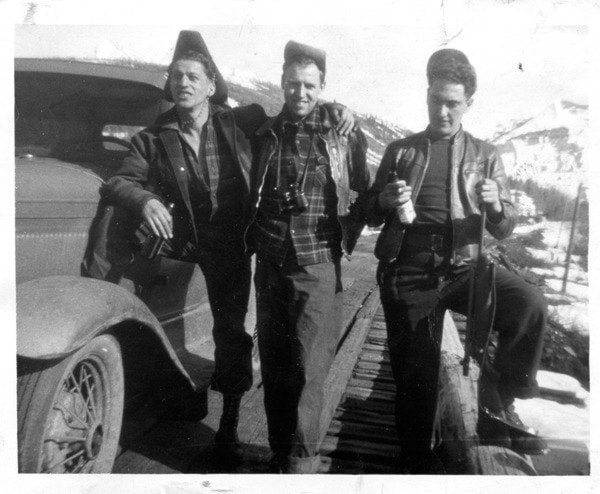Sparwood’s Popeye Fontana hands me a small white envelope. Contained inside, carefully folded, is a yellowed clipping from the Nelson Daily News dated March 20, 1929.
The article is about finding oil in the Flathead and leads to a discussion on the oil derrick in Fernie and changes made that have noticeably improved the appearance of the structure, artifacts and land.
This wood replica of Akamina 1 and 2 oil derricks from the Flathead is the last one standing in B.C, making it and the actual metal artifact a very significant part of B.C. history.
Metal components from these oil wells are on perpetual loan for exhibition at the prestigious Museum of Civilization in Ottawa as well.
Five years ago a group came to City Council requesting the oil rig be torn down, citing concerns for safety and appearance.
Popeye’s love for history helps him understand why I took on the challenge of convincing council that even though this valuable artifact needed improvements it was still an asset worth keeping for our community.
Ted Renner, I and others joined to form a society in 2007. Council then gave approval to Fernie Derrick Society to take charge and make site improvements.
Grant funding and in kind assistance from local contractors, professionals and the City was obtained and Alex Millar, Grant Laird, Gerrit van der Geest, Fred Lightfoot, Bob Morris and I got to work.
The structure was secured, wood parts re-built and metal components restored. The large boiler was moved forward and placed on a concrete base as were other artifacts. The unsightly chain link fence and posts were removed, bushes trimmed, interpretive signage designed and lighting placed strategically so the derrick is visible at night.
Popeye and I discussed that there are people that still think the derrick is a misrepresentation of our area’s history. He commented that coal, gas and oil are connected, coming from the same source. Even decades ago this was known by those that pushed for resource extraction in the Flathead.
I scan the headlines of the editorial. “Oil empire in Flathead only requires roads.” “Great oil, coal, timber and power valley is held back,” said James Fisher, pioneer of the Flathead. “Is accessible only by Montana as yet.” “B.C. oil strikes wet gas.” The article obviously deemed it so important it needed four headlines in varying sizes.
“An oil empire that also has valuable timber and numerous water powers may be added to this province and to the Kootenay any day, in the shape of the Flathead Valley and it is high time this potential oil field received official encouragement by the province, in the shape of access from this side of the line instead of being dependent on Montana,” claimed Fisher.
The article goes on to say Fisher had lived in the Flathead for 27 years and was in Nelson to recruit friends’ help in getting government recognition. It compares the area to Alberta’s Turner Valley mentioning the road between Corbin and McGillivray. Apparently Fisher was getting a 600 acre lease in association with Beaver Oil who was interested in investing $75, 000.
“That was a lot of money back then,” Popeye commented, adding in 1947 he knew Mary Madge, who owned wells. “I used to camp at her oil well.
One year she had pipes stolen, she came to Sparwood to ask if I had seen anything. An original Studebaker eight cylinder gas engine was used to run Madge’s well.”
According to the article the Kootenay oil well produced 50 barrels in one month.
Popeye has spent a lot of time in the Flathead. He plans on taking a trip to Sage Creek to see what’s left of an oil well there and take photos.
His first trip was in 1939. “I was just a kid, but I knew where they all were. Proctor Lake had an oil well too.
“We found Diamond City in the Flathead where the big shots gathered. It’s preserved now, no trees to be cut there. I knew the McDougall’s - Americans who lived in Canada. They hunted, guided and lived there. The grandson just wrote a book “Sage creek and I.” Buzz, Kinky (Borsato), Hank, Trosty, (Kenny McFarlane), Jimmy, Lant and I would go exploring.
“We travelled on horseback from Michel to the border, two weeks at a time; we were free to move back and forth - not anymore. There used to be a sign that read, ‘If you’re Canadian report at the gas station in Polebridge.’
“I organized the Corbin Wildlife Society - we studied wildlife, water, and made recommendations on mining, fishing and heritage to Forestry, and groups in Cranbrook. Jim did all the talking. He was a natural at it.
“Now everyone is gone, I’m dissolving the society, shutting it down.”
Popeye sounds wistful. “It’s difficult to keep a club going when friends are gone.”
In 1929 Fisher said the Flathead had “some of the finest coal showing in the province” along with timber and water at the Sage, Couldrey, Cabin, Howell and Sheep creeks and he considered this a huge asset that needed to be developed.
While exploring, Popeye found small mines with tools and wheelbarrows.
He retains facts and information gathered during his days of guiding and exploring.
He’s pleased the government isn’t allowing resource removal in the Flathead, believing future generations should have privilege to enjoy the land.
Pushing just past 80, this man continues to roam the country he loves so much although his eyes beam as he says “don’t use horses any more, use quads.”
